National Education Policy Transformation in Malaysia: A Report
VerifiedAdded on 2020/07/22
|29
|8607
|110
Report
AI Summary
This report provides a comprehensive analysis of the transformation of Malaysia's National Education Policy, examining its evolution from 1957 to the present. The report delves into the performance of the education system, highlighting key changes and reforms implemented over the decades, including the shift from hut schools to a centralized national system. It assesses the impact of various policies, such as the Education Act of 1961 and the Vision 2020 initiative, on literacy rates, school infrastructure, and student enrollment. Furthermore, the report offers a comparative analysis of Malaysia's education system with Singapore's, identifying strengths and weaknesses. The report also proposes a conceptual model for future transformation, focusing on addressing performance gaps and enhancing the quality of education. It includes tables with statistical data on literacy rates, school types, and school numbers. The report concludes with reflections on critical thinking, leadership skills, and competencies required for future development in the context of educational consultancy.
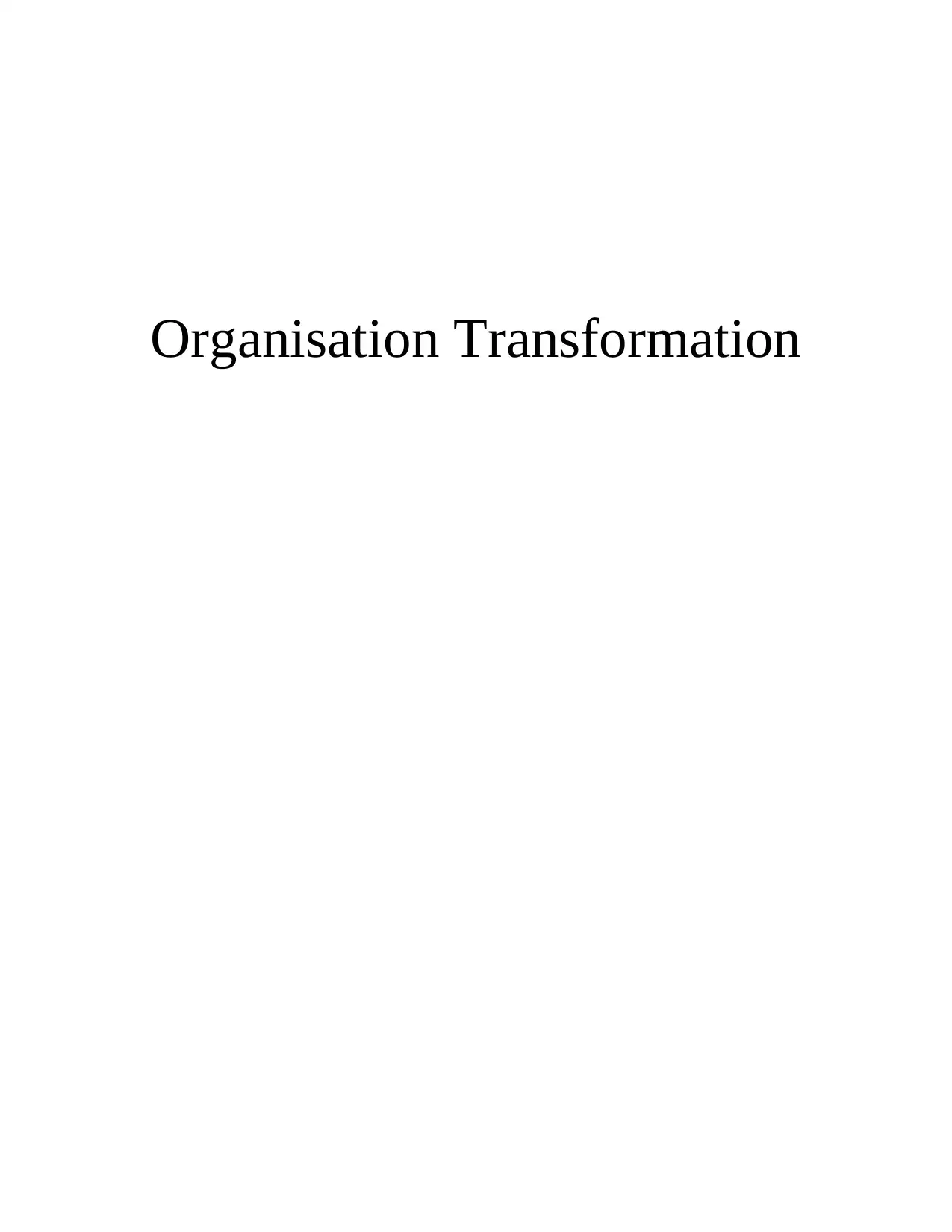
Organisation Transformation
Paraphrase This Document
Need a fresh take? Get an instant paraphrase of this document with our AI Paraphraser
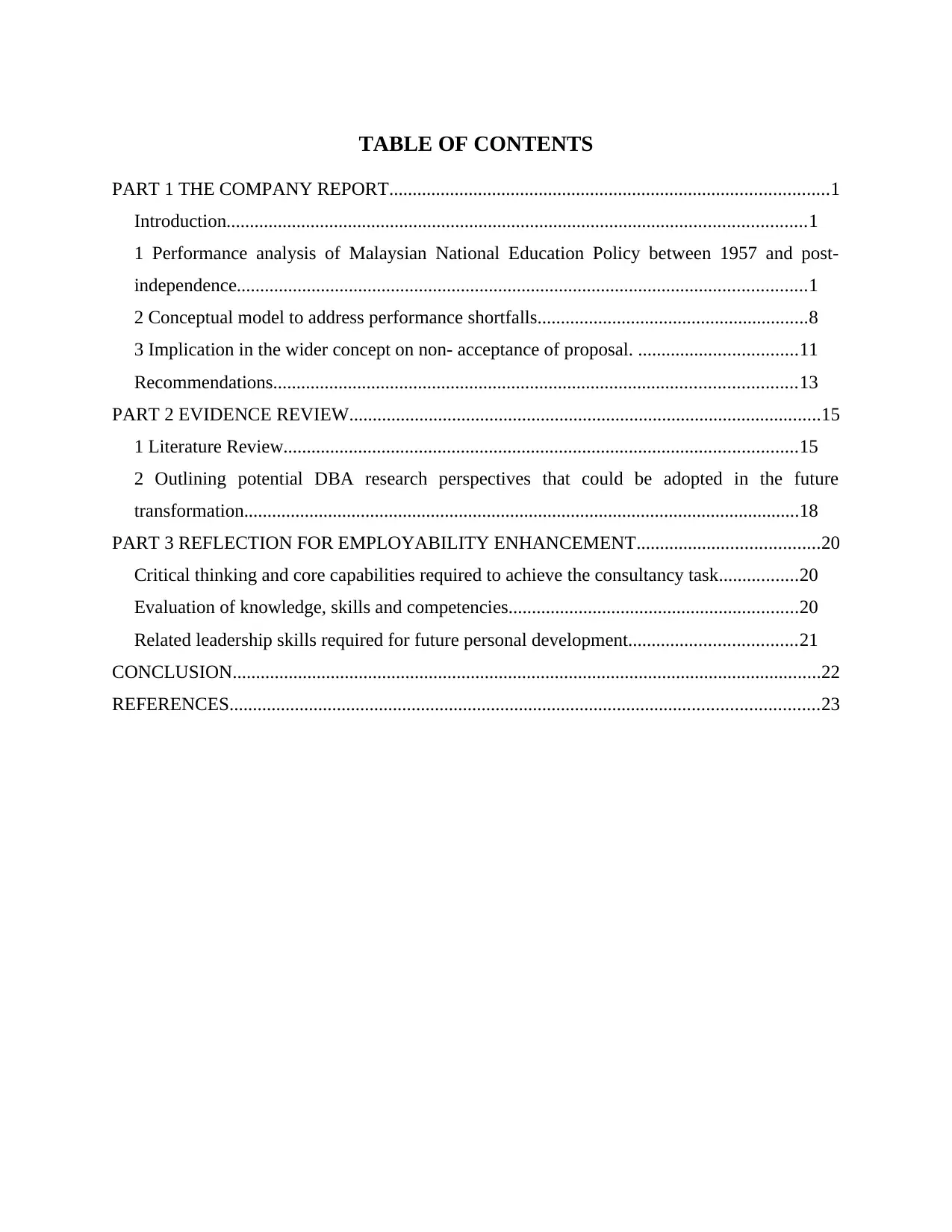
TABLE OF CONTENTS
PART 1 THE COMPANY REPORT..............................................................................................1
Introduction............................................................................................................................1
1 Performance analysis of Malaysian National Education Policy between 1957 and post-
independence..........................................................................................................................1
2 Conceptual model to address performance shortfalls..........................................................8
3 Implication in the wider concept on non- acceptance of proposal. ..................................11
Recommendations................................................................................................................13
PART 2 EVIDENCE REVIEW.....................................................................................................15
1 Literature Review..............................................................................................................15
2 Outlining potential DBA research perspectives that could be adopted in the future
transformation.......................................................................................................................18
PART 3 REFLECTION FOR EMPLOYABILITY ENHANCEMENT.......................................20
Critical thinking and core capabilities required to achieve the consultancy task.................20
Evaluation of knowledge, skills and competencies..............................................................20
Related leadership skills required for future personal development....................................21
CONCLUSION..............................................................................................................................22
REFERENCES..............................................................................................................................23
PART 1 THE COMPANY REPORT..............................................................................................1
Introduction............................................................................................................................1
1 Performance analysis of Malaysian National Education Policy between 1957 and post-
independence..........................................................................................................................1
2 Conceptual model to address performance shortfalls..........................................................8
3 Implication in the wider concept on non- acceptance of proposal. ..................................11
Recommendations................................................................................................................13
PART 2 EVIDENCE REVIEW.....................................................................................................15
1 Literature Review..............................................................................................................15
2 Outlining potential DBA research perspectives that could be adopted in the future
transformation.......................................................................................................................18
PART 3 REFLECTION FOR EMPLOYABILITY ENHANCEMENT.......................................20
Critical thinking and core capabilities required to achieve the consultancy task.................20
Evaluation of knowledge, skills and competencies..............................................................20
Related leadership skills required for future personal development....................................21
CONCLUSION..............................................................................................................................22
REFERENCES..............................................................................................................................23
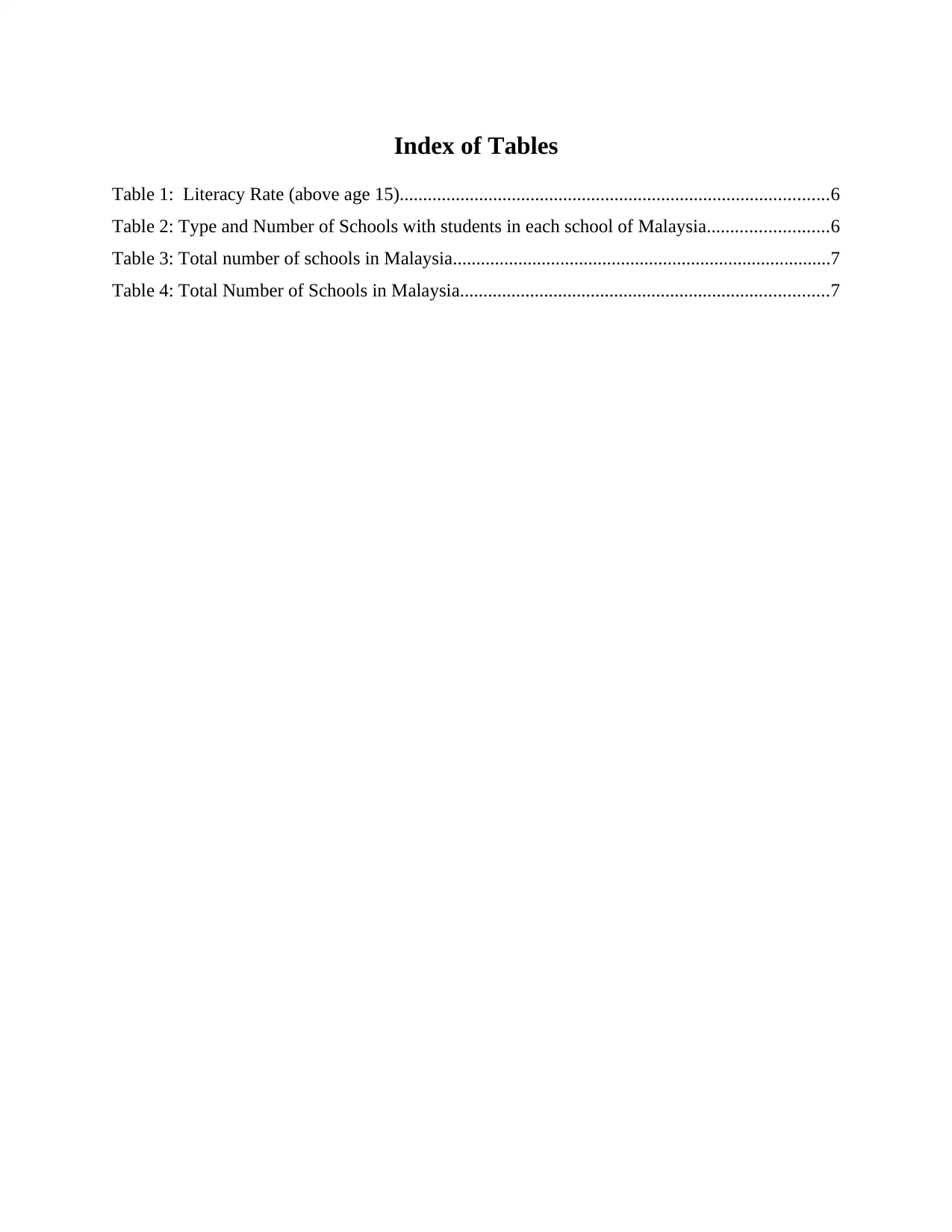
Index of Tables
Table 1: Literacy Rate (above age 15)............................................................................................6
Table 2: Type and Number of Schools with students in each school of Malaysia..........................6
Table 3: Total number of schools in Malaysia.................................................................................7
Table 4: Total Number of Schools in Malaysia...............................................................................7
Table 1: Literacy Rate (above age 15)............................................................................................6
Table 2: Type and Number of Schools with students in each school of Malaysia..........................6
Table 3: Total number of schools in Malaysia.................................................................................7
Table 4: Total Number of Schools in Malaysia...............................................................................7
⊘ This is a preview!⊘
Do you want full access?
Subscribe today to unlock all pages.

Trusted by 1+ million students worldwide
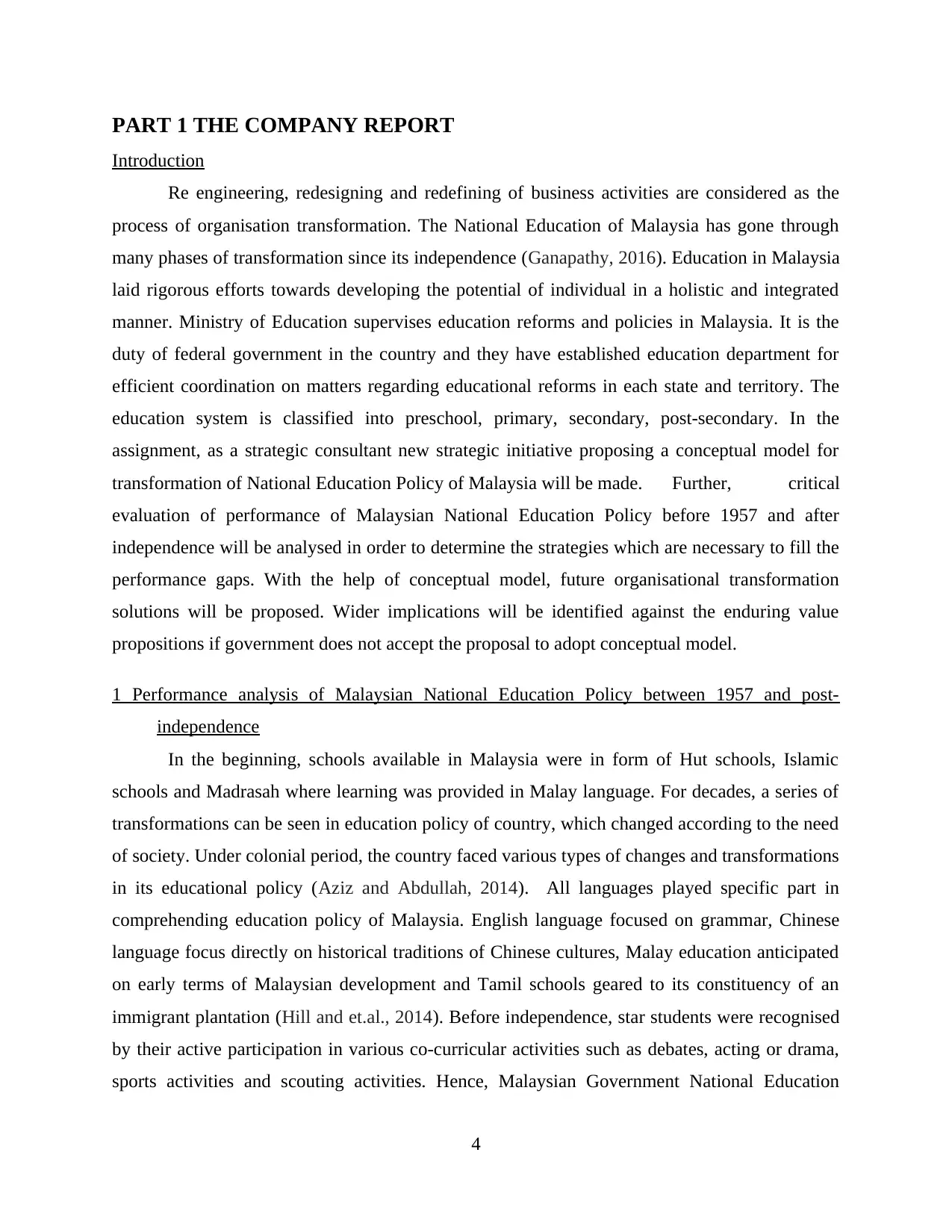
PART 1 THE COMPANY REPORT
Introduction
Re engineering, redesigning and redefining of business activities are considered as the
process of organisation transformation. The National Education of Malaysia has gone through
many phases of transformation since its independence (Ganapathy, 2016). Education in Malaysia
laid rigorous efforts towards developing the potential of individual in a holistic and integrated
manner. Ministry of Education supervises education reforms and policies in Malaysia. It is the
duty of federal government in the country and they have established education department for
efficient coordination on matters regarding educational reforms in each state and territory. The
education system is classified into preschool, primary, secondary, post-secondary. In the
assignment, as a strategic consultant new strategic initiative proposing a conceptual model for
transformation of National Education Policy of Malaysia will be made. Further, critical
evaluation of performance of Malaysian National Education Policy before 1957 and after
independence will be analysed in order to determine the strategies which are necessary to fill the
performance gaps. With the help of conceptual model, future organisational transformation
solutions will be proposed. Wider implications will be identified against the enduring value
propositions if government does not accept the proposal to adopt conceptual model.
1 Performance analysis of Malaysian National Education Policy between 1957 and post-
independence
In the beginning, schools available in Malaysia were in form of Hut schools, Islamic
schools and Madrasah where learning was provided in Malay language. For decades, a series of
transformations can be seen in education policy of country, which changed according to the need
of society. Under colonial period, the country faced various types of changes and transformations
in its educational policy (Aziz and Abdullah, 2014). All languages played specific part in
comprehending education policy of Malaysia. English language focused on grammar, Chinese
language focus directly on historical traditions of Chinese cultures, Malay education anticipated
on early terms of Malaysian development and Tamil schools geared to its constituency of an
immigrant plantation (Hill and et.al., 2014). Before independence, star students were recognised
by their active participation in various co-curricular activities such as debates, acting or drama,
sports activities and scouting activities. Hence, Malaysian Government National Education
4
Introduction
Re engineering, redesigning and redefining of business activities are considered as the
process of organisation transformation. The National Education of Malaysia has gone through
many phases of transformation since its independence (Ganapathy, 2016). Education in Malaysia
laid rigorous efforts towards developing the potential of individual in a holistic and integrated
manner. Ministry of Education supervises education reforms and policies in Malaysia. It is the
duty of federal government in the country and they have established education department for
efficient coordination on matters regarding educational reforms in each state and territory. The
education system is classified into preschool, primary, secondary, post-secondary. In the
assignment, as a strategic consultant new strategic initiative proposing a conceptual model for
transformation of National Education Policy of Malaysia will be made. Further, critical
evaluation of performance of Malaysian National Education Policy before 1957 and after
independence will be analysed in order to determine the strategies which are necessary to fill the
performance gaps. With the help of conceptual model, future organisational transformation
solutions will be proposed. Wider implications will be identified against the enduring value
propositions if government does not accept the proposal to adopt conceptual model.
1 Performance analysis of Malaysian National Education Policy between 1957 and post-
independence
In the beginning, schools available in Malaysia were in form of Hut schools, Islamic
schools and Madrasah where learning was provided in Malay language. For decades, a series of
transformations can be seen in education policy of country, which changed according to the need
of society. Under colonial period, the country faced various types of changes and transformations
in its educational policy (Aziz and Abdullah, 2014). All languages played specific part in
comprehending education policy of Malaysia. English language focused on grammar, Chinese
language focus directly on historical traditions of Chinese cultures, Malay education anticipated
on early terms of Malaysian development and Tamil schools geared to its constituency of an
immigrant plantation (Hill and et.al., 2014). Before independence, star students were recognised
by their active participation in various co-curricular activities such as debates, acting or drama,
sports activities and scouting activities. Hence, Malaysian Government National Education
4
Paraphrase This Document
Need a fresh take? Get an instant paraphrase of this document with our AI Paraphraser
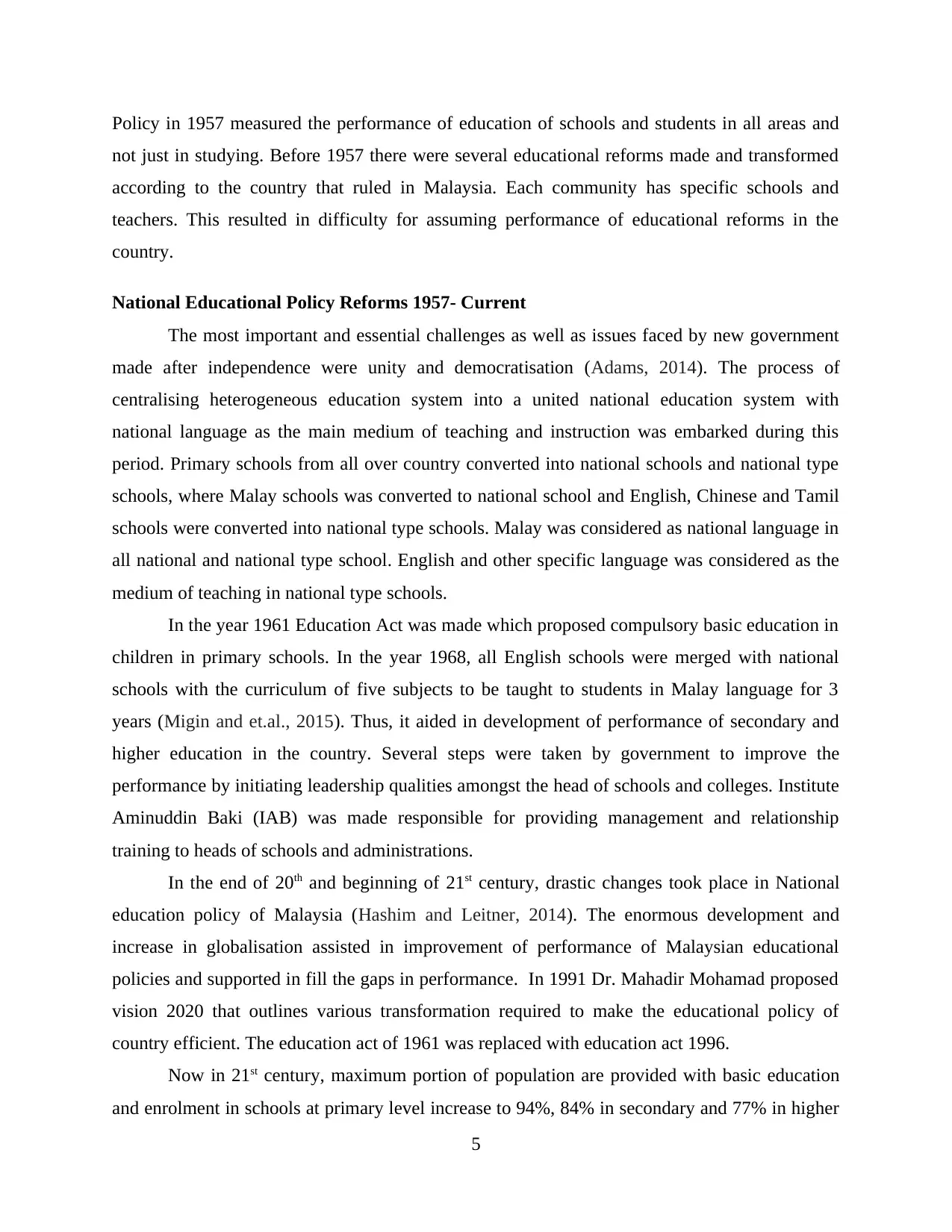
Policy in 1957 measured the performance of education of schools and students in all areas and
not just in studying. Before 1957 there were several educational reforms made and transformed
according to the country that ruled in Malaysia. Each community has specific schools and
teachers. This resulted in difficulty for assuming performance of educational reforms in the
country.
National Educational Policy Reforms 1957- Current
The most important and essential challenges as well as issues faced by new government
made after independence were unity and democratisation (Adams, 2014). The process of
centralising heterogeneous education system into a united national education system with
national language as the main medium of teaching and instruction was embarked during this
period. Primary schools from all over country converted into national schools and national type
schools, where Malay schools was converted to national school and English, Chinese and Tamil
schools were converted into national type schools. Malay was considered as national language in
all national and national type school. English and other specific language was considered as the
medium of teaching in national type schools.
In the year 1961 Education Act was made which proposed compulsory basic education in
children in primary schools. In the year 1968, all English schools were merged with national
schools with the curriculum of five subjects to be taught to students in Malay language for 3
years (Migin and et.al., 2015). Thus, it aided in development of performance of secondary and
higher education in the country. Several steps were taken by government to improve the
performance by initiating leadership qualities amongst the head of schools and colleges. Institute
Aminuddin Baki (IAB) was made responsible for providing management and relationship
training to heads of schools and administrations.
In the end of 20th and beginning of 21st century, drastic changes took place in National
education policy of Malaysia (Hashim and Leitner, 2014). The enormous development and
increase in globalisation assisted in improvement of performance of Malaysian educational
policies and supported in fill the gaps in performance. In 1991 Dr. Mahadir Mohamad proposed
vision 2020 that outlines various transformation required to make the educational policy of
country efficient. The education act of 1961 was replaced with education act 1996.
Now in 21st century, maximum portion of population are provided with basic education
and enrolment in schools at primary level increase to 94%, 84% in secondary and 77% in higher
5
not just in studying. Before 1957 there were several educational reforms made and transformed
according to the country that ruled in Malaysia. Each community has specific schools and
teachers. This resulted in difficulty for assuming performance of educational reforms in the
country.
National Educational Policy Reforms 1957- Current
The most important and essential challenges as well as issues faced by new government
made after independence were unity and democratisation (Adams, 2014). The process of
centralising heterogeneous education system into a united national education system with
national language as the main medium of teaching and instruction was embarked during this
period. Primary schools from all over country converted into national schools and national type
schools, where Malay schools was converted to national school and English, Chinese and Tamil
schools were converted into national type schools. Malay was considered as national language in
all national and national type school. English and other specific language was considered as the
medium of teaching in national type schools.
In the year 1961 Education Act was made which proposed compulsory basic education in
children in primary schools. In the year 1968, all English schools were merged with national
schools with the curriculum of five subjects to be taught to students in Malay language for 3
years (Migin and et.al., 2015). Thus, it aided in development of performance of secondary and
higher education in the country. Several steps were taken by government to improve the
performance by initiating leadership qualities amongst the head of schools and colleges. Institute
Aminuddin Baki (IAB) was made responsible for providing management and relationship
training to heads of schools and administrations.
In the end of 20th and beginning of 21st century, drastic changes took place in National
education policy of Malaysia (Hashim and Leitner, 2014). The enormous development and
increase in globalisation assisted in improvement of performance of Malaysian educational
policies and supported in fill the gaps in performance. In 1991 Dr. Mahadir Mohamad proposed
vision 2020 that outlines various transformation required to make the educational policy of
country efficient. The education act of 1961 was replaced with education act 1996.
Now in 21st century, maximum portion of population are provided with basic education
and enrolment in schools at primary level increase to 94%, 84% in secondary and 77% in higher
5
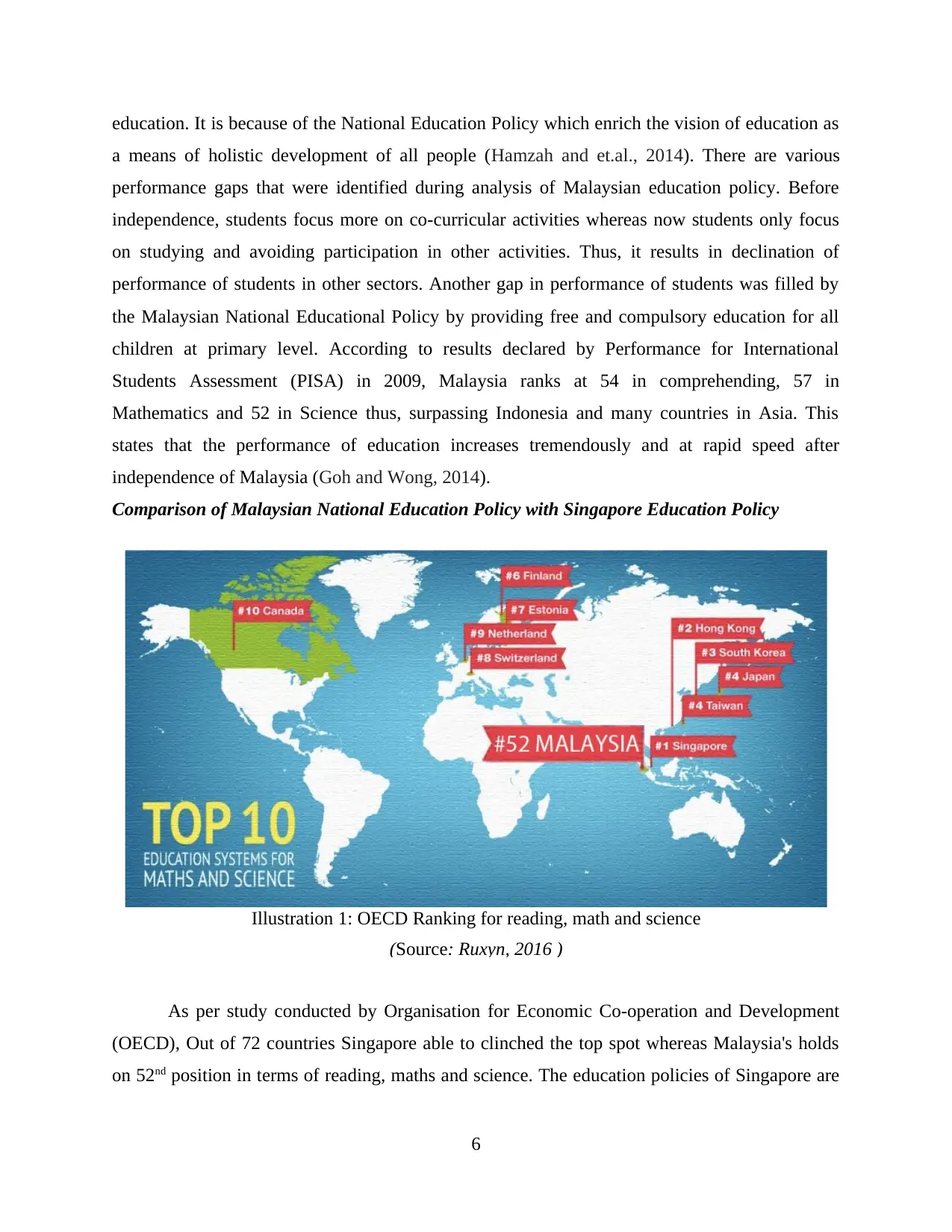
education. It is because of the National Education Policy which enrich the vision of education as
a means of holistic development of all people (Hamzah and et.al., 2014). There are various
performance gaps that were identified during analysis of Malaysian education policy. Before
independence, students focus more on co-curricular activities whereas now students only focus
on studying and avoiding participation in other activities. Thus, it results in declination of
performance of students in other sectors. Another gap in performance of students was filled by
the Malaysian National Educational Policy by providing free and compulsory education for all
children at primary level. According to results declared by Performance for International
Students Assessment (PISA) in 2009, Malaysia ranks at 54 in comprehending, 57 in
Mathematics and 52 in Science thus, surpassing Indonesia and many countries in Asia. This
states that the performance of education increases tremendously and at rapid speed after
independence of Malaysia (Goh and Wong, 2014).
Comparison of Malaysian National Education Policy with Singapore Education Policy
As per study conducted by Organisation for Economic Co-operation and Development
(OECD), Out of 72 countries Singapore able to clinched the top spot whereas Malaysia's holds
on 52nd position in terms of reading, maths and science. The education policies of Singapore are
6
Illustration 1: OECD Ranking for reading, math and science
(Source: Ruxyn, 2016 )
a means of holistic development of all people (Hamzah and et.al., 2014). There are various
performance gaps that were identified during analysis of Malaysian education policy. Before
independence, students focus more on co-curricular activities whereas now students only focus
on studying and avoiding participation in other activities. Thus, it results in declination of
performance of students in other sectors. Another gap in performance of students was filled by
the Malaysian National Educational Policy by providing free and compulsory education for all
children at primary level. According to results declared by Performance for International
Students Assessment (PISA) in 2009, Malaysia ranks at 54 in comprehending, 57 in
Mathematics and 52 in Science thus, surpassing Indonesia and many countries in Asia. This
states that the performance of education increases tremendously and at rapid speed after
independence of Malaysia (Goh and Wong, 2014).
Comparison of Malaysian National Education Policy with Singapore Education Policy
As per study conducted by Organisation for Economic Co-operation and Development
(OECD), Out of 72 countries Singapore able to clinched the top spot whereas Malaysia's holds
on 52nd position in terms of reading, maths and science. The education policies of Singapore are
6
Illustration 1: OECD Ranking for reading, math and science
(Source: Ruxyn, 2016 )
⊘ This is a preview!⊘
Do you want full access?
Subscribe today to unlock all pages.

Trusted by 1+ million students worldwide
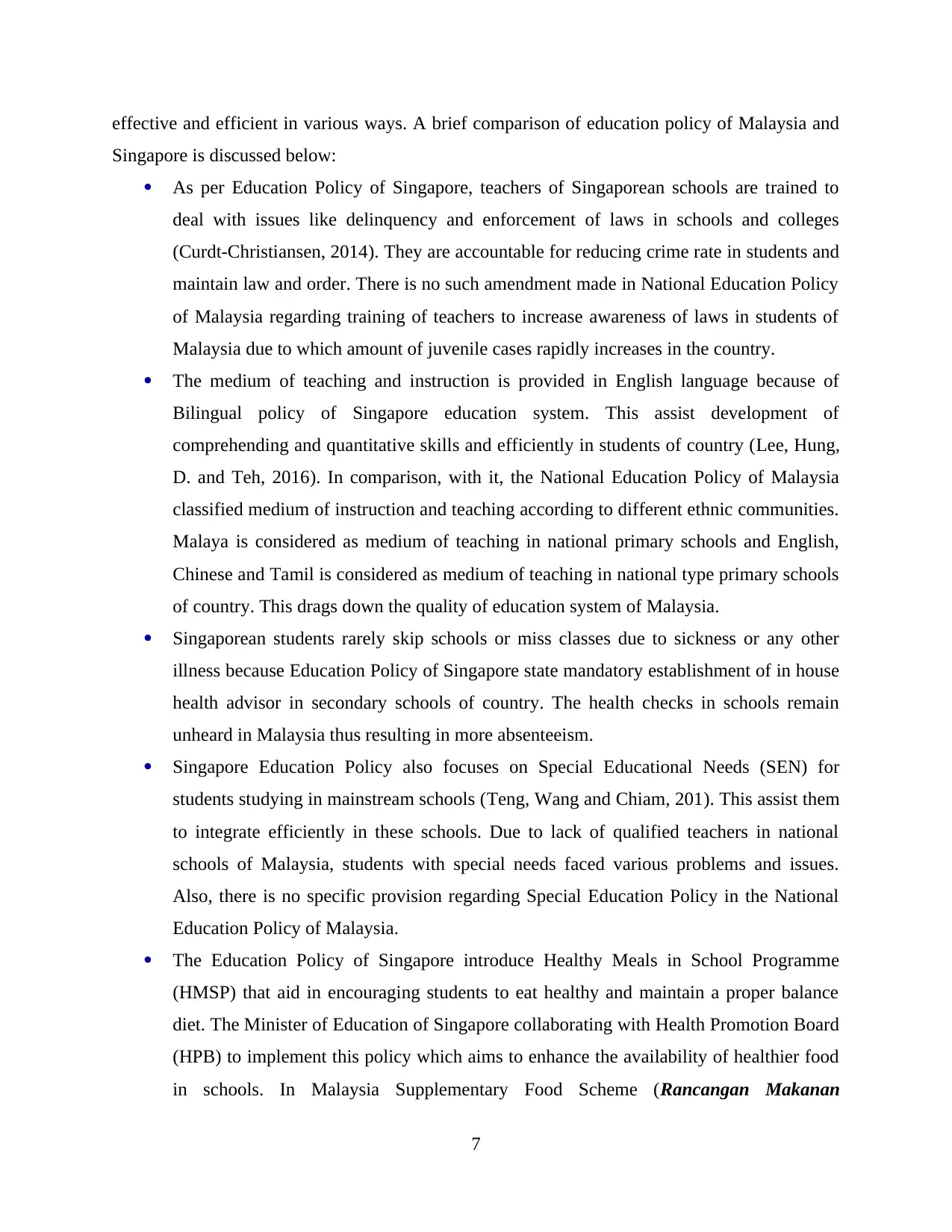
effective and efficient in various ways. A brief comparison of education policy of Malaysia and
Singapore is discussed below:
As per Education Policy of Singapore, teachers of Singaporean schools are trained to
deal with issues like delinquency and enforcement of laws in schools and colleges
(Curdt-Christiansen, 2014). They are accountable for reducing crime rate in students and
maintain law and order. There is no such amendment made in National Education Policy
of Malaysia regarding training of teachers to increase awareness of laws in students of
Malaysia due to which amount of juvenile cases rapidly increases in the country.
The medium of teaching and instruction is provided in English language because of
Bilingual policy of Singapore education system. This assist development of
comprehending and quantitative skills and efficiently in students of country (Lee, Hung,
D. and Teh, 2016). In comparison, with it, the National Education Policy of Malaysia
classified medium of instruction and teaching according to different ethnic communities.
Malaya is considered as medium of teaching in national primary schools and English,
Chinese and Tamil is considered as medium of teaching in national type primary schools
of country. This drags down the quality of education system of Malaysia.
Singaporean students rarely skip schools or miss classes due to sickness or any other
illness because Education Policy of Singapore state mandatory establishment of in house
health advisor in secondary schools of country. The health checks in schools remain
unheard in Malaysia thus resulting in more absenteeism.
Singapore Education Policy also focuses on Special Educational Needs (SEN) for
students studying in mainstream schools (Teng, Wang and Chiam, 201). This assist them
to integrate efficiently in these schools. Due to lack of qualified teachers in national
schools of Malaysia, students with special needs faced various problems and issues.
Also, there is no specific provision regarding Special Education Policy in the National
Education Policy of Malaysia.
The Education Policy of Singapore introduce Healthy Meals in School Programme
(HMSP) that aid in encouraging students to eat healthy and maintain a proper balance
diet. The Minister of Education of Singapore collaborating with Health Promotion Board
(HPB) to implement this policy which aims to enhance the availability of healthier food
in schools. In Malaysia Supplementary Food Scheme (Rancangan Makanan
7
Singapore is discussed below:
As per Education Policy of Singapore, teachers of Singaporean schools are trained to
deal with issues like delinquency and enforcement of laws in schools and colleges
(Curdt-Christiansen, 2014). They are accountable for reducing crime rate in students and
maintain law and order. There is no such amendment made in National Education Policy
of Malaysia regarding training of teachers to increase awareness of laws in students of
Malaysia due to which amount of juvenile cases rapidly increases in the country.
The medium of teaching and instruction is provided in English language because of
Bilingual policy of Singapore education system. This assist development of
comprehending and quantitative skills and efficiently in students of country (Lee, Hung,
D. and Teh, 2016). In comparison, with it, the National Education Policy of Malaysia
classified medium of instruction and teaching according to different ethnic communities.
Malaya is considered as medium of teaching in national primary schools and English,
Chinese and Tamil is considered as medium of teaching in national type primary schools
of country. This drags down the quality of education system of Malaysia.
Singaporean students rarely skip schools or miss classes due to sickness or any other
illness because Education Policy of Singapore state mandatory establishment of in house
health advisor in secondary schools of country. The health checks in schools remain
unheard in Malaysia thus resulting in more absenteeism.
Singapore Education Policy also focuses on Special Educational Needs (SEN) for
students studying in mainstream schools (Teng, Wang and Chiam, 201). This assist them
to integrate efficiently in these schools. Due to lack of qualified teachers in national
schools of Malaysia, students with special needs faced various problems and issues.
Also, there is no specific provision regarding Special Education Policy in the National
Education Policy of Malaysia.
The Education Policy of Singapore introduce Healthy Meals in School Programme
(HMSP) that aid in encouraging students to eat healthy and maintain a proper balance
diet. The Minister of Education of Singapore collaborating with Health Promotion Board
(HPB) to implement this policy which aims to enhance the availability of healthier food
in schools. In Malaysia Supplementary Food Scheme (Rancangan Makanan
7
Paraphrase This Document
Need a fresh take? Get an instant paraphrase of this document with our AI Paraphraser
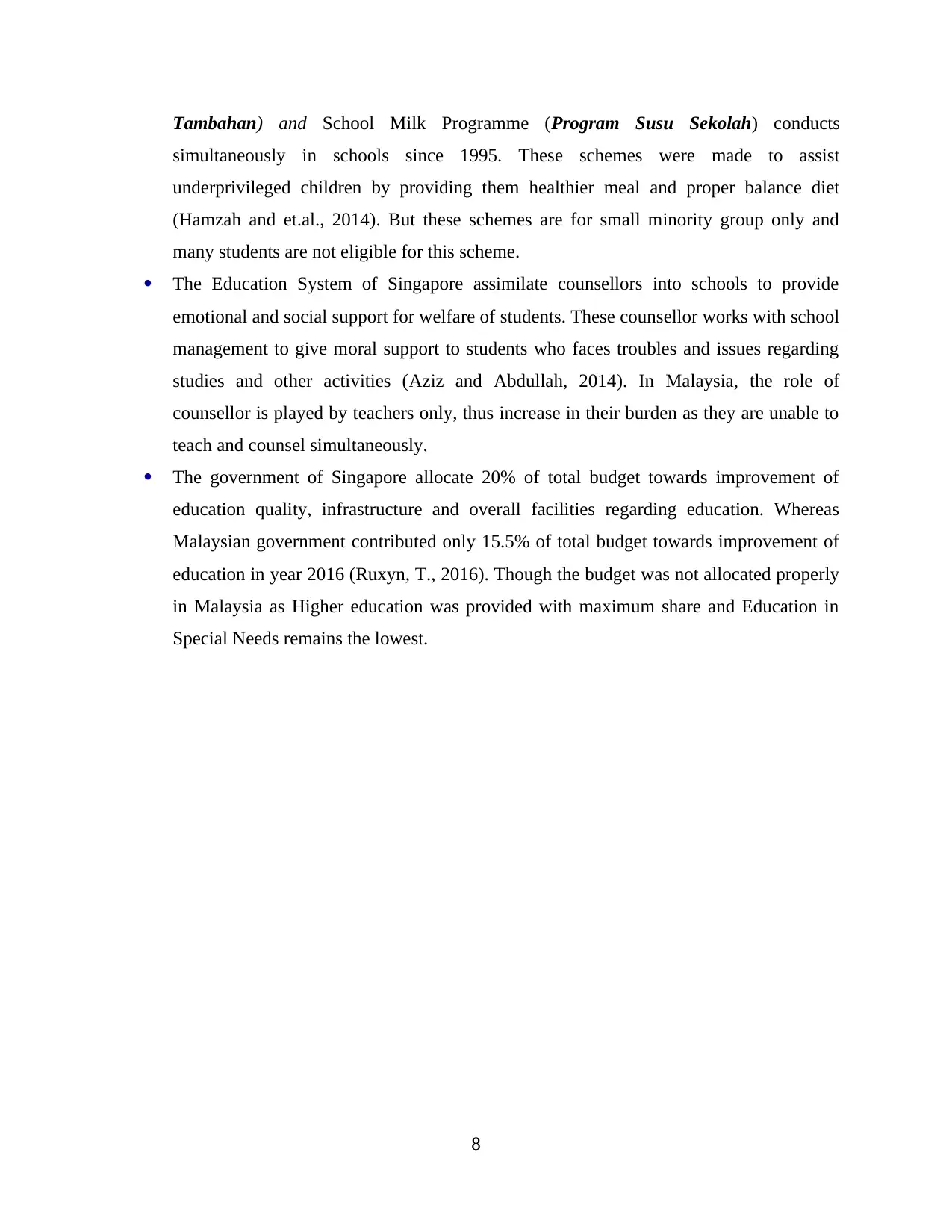
Tambahan) and School Milk Programme (Program Susu Sekolah) conducts
simultaneously in schools since 1995. These schemes were made to assist
underprivileged children by providing them healthier meal and proper balance diet
(Hamzah and et.al., 2014). But these schemes are for small minority group only and
many students are not eligible for this scheme.
The Education System of Singapore assimilate counsellors into schools to provide
emotional and social support for welfare of students. These counsellor works with school
management to give moral support to students who faces troubles and issues regarding
studies and other activities (Aziz and Abdullah, 2014). In Malaysia, the role of
counsellor is played by teachers only, thus increase in their burden as they are unable to
teach and counsel simultaneously.
The government of Singapore allocate 20% of total budget towards improvement of
education quality, infrastructure and overall facilities regarding education. Whereas
Malaysian government contributed only 15.5% of total budget towards improvement of
education in year 2016 (Ruxyn, T., 2016). Though the budget was not allocated properly
in Malaysia as Higher education was provided with maximum share and Education in
Special Needs remains the lowest.
8
simultaneously in schools since 1995. These schemes were made to assist
underprivileged children by providing them healthier meal and proper balance diet
(Hamzah and et.al., 2014). But these schemes are for small minority group only and
many students are not eligible for this scheme.
The Education System of Singapore assimilate counsellors into schools to provide
emotional and social support for welfare of students. These counsellor works with school
management to give moral support to students who faces troubles and issues regarding
studies and other activities (Aziz and Abdullah, 2014). In Malaysia, the role of
counsellor is played by teachers only, thus increase in their burden as they are unable to
teach and counsel simultaneously.
The government of Singapore allocate 20% of total budget towards improvement of
education quality, infrastructure and overall facilities regarding education. Whereas
Malaysian government contributed only 15.5% of total budget towards improvement of
education in year 2016 (Ruxyn, T., 2016). Though the budget was not allocated properly
in Malaysia as Higher education was provided with maximum share and Education in
Special Needs remains the lowest.
8
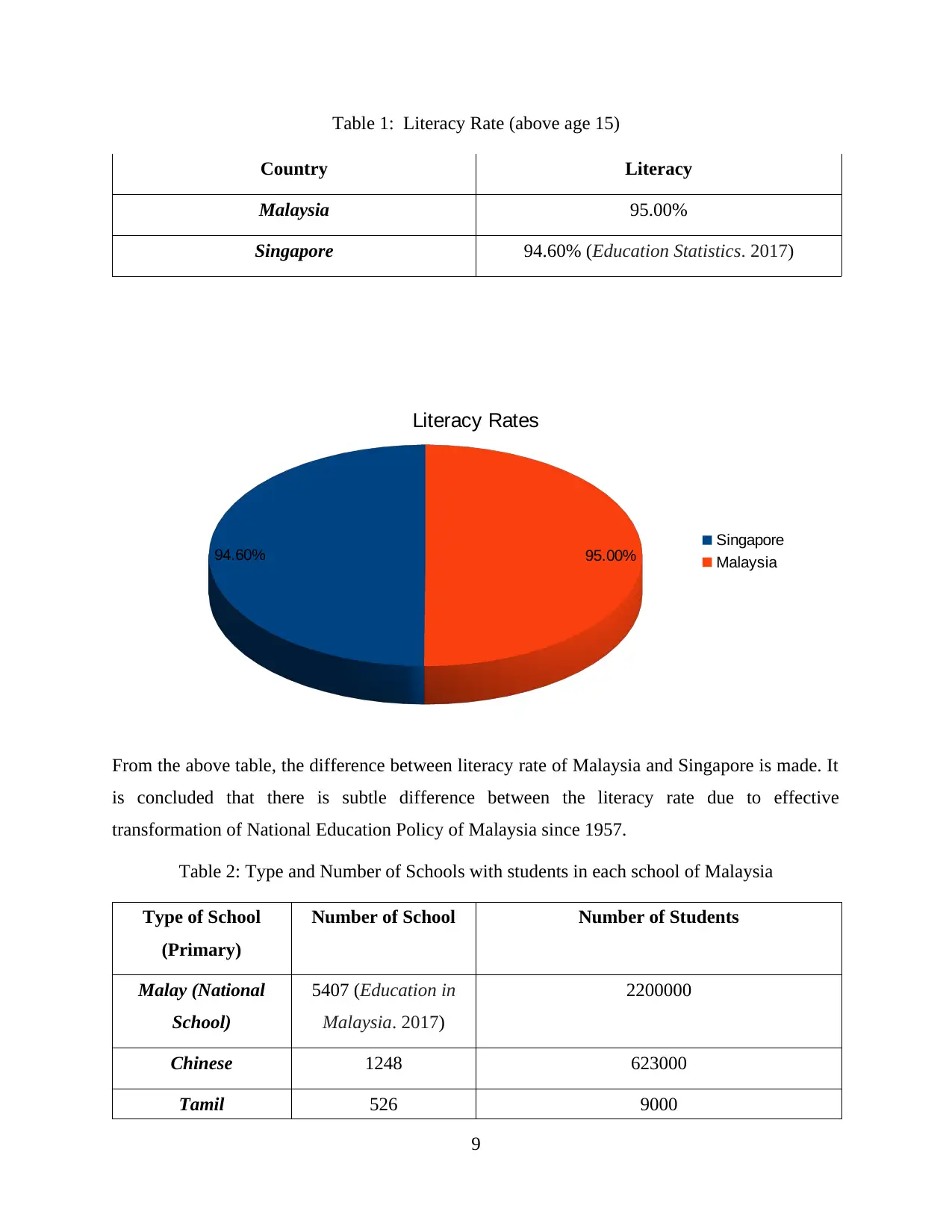
Table 1: Literacy Rate (above age 15)
Country Literacy
Malaysia 95.00%
Singapore 94.60% (Education Statistics. 2017)
From the above table, the difference between literacy rate of Malaysia and Singapore is made. It
is concluded that there is subtle difference between the literacy rate due to effective
transformation of National Education Policy of Malaysia since 1957.
Table 2: Type and Number of Schools with students in each school of Malaysia
Type of School
(Primary)
Number of School Number of Students
Malay (National
School)
5407 (Education in
Malaysia. 2017)
2200000
Chinese 1248 623000
Tamil 526 9000
9
94.60% 95.00%
Literacy Rates
Singapore
Malaysia
Country Literacy
Malaysia 95.00%
Singapore 94.60% (Education Statistics. 2017)
From the above table, the difference between literacy rate of Malaysia and Singapore is made. It
is concluded that there is subtle difference between the literacy rate due to effective
transformation of National Education Policy of Malaysia since 1957.
Table 2: Type and Number of Schools with students in each school of Malaysia
Type of School
(Primary)
Number of School Number of Students
Malay (National
School)
5407 (Education in
Malaysia. 2017)
2200000
Chinese 1248 623000
Tamil 526 9000
9
94.60% 95.00%
Literacy Rates
Singapore
Malaysia
⊘ This is a preview!⊘
Do you want full access?
Subscribe today to unlock all pages.

Trusted by 1+ million students worldwide
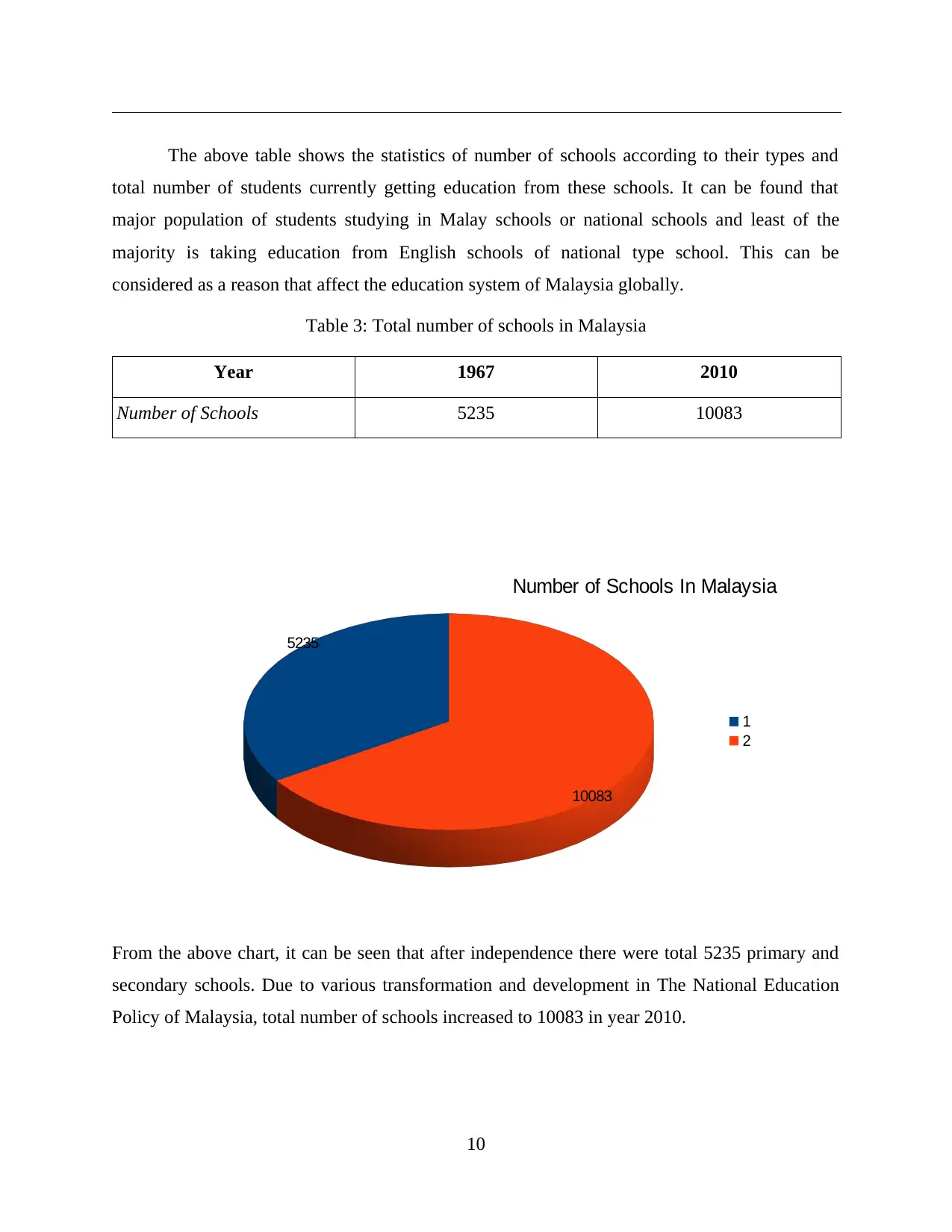
The above table shows the statistics of number of schools according to their types and
total number of students currently getting education from these schools. It can be found that
major population of students studying in Malay schools or national schools and least of the
majority is taking education from English schools of national type school. This can be
considered as a reason that affect the education system of Malaysia globally.
Table 3: Total number of schools in Malaysia
Year 1967 2010
Number of Schools 5235 10083
From the above chart, it can be seen that after independence there were total 5235 primary and
secondary schools. Due to various transformation and development in The National Education
Policy of Malaysia, total number of schools increased to 10083 in year 2010.
10
5235
10083
Number of Schools In Malaysia
1
2
total number of students currently getting education from these schools. It can be found that
major population of students studying in Malay schools or national schools and least of the
majority is taking education from English schools of national type school. This can be
considered as a reason that affect the education system of Malaysia globally.
Table 3: Total number of schools in Malaysia
Year 1967 2010
Number of Schools 5235 10083
From the above chart, it can be seen that after independence there were total 5235 primary and
secondary schools. Due to various transformation and development in The National Education
Policy of Malaysia, total number of schools increased to 10083 in year 2010.
10
5235
10083
Number of Schools In Malaysia
1
2
Paraphrase This Document
Need a fresh take? Get an instant paraphrase of this document with our AI Paraphraser
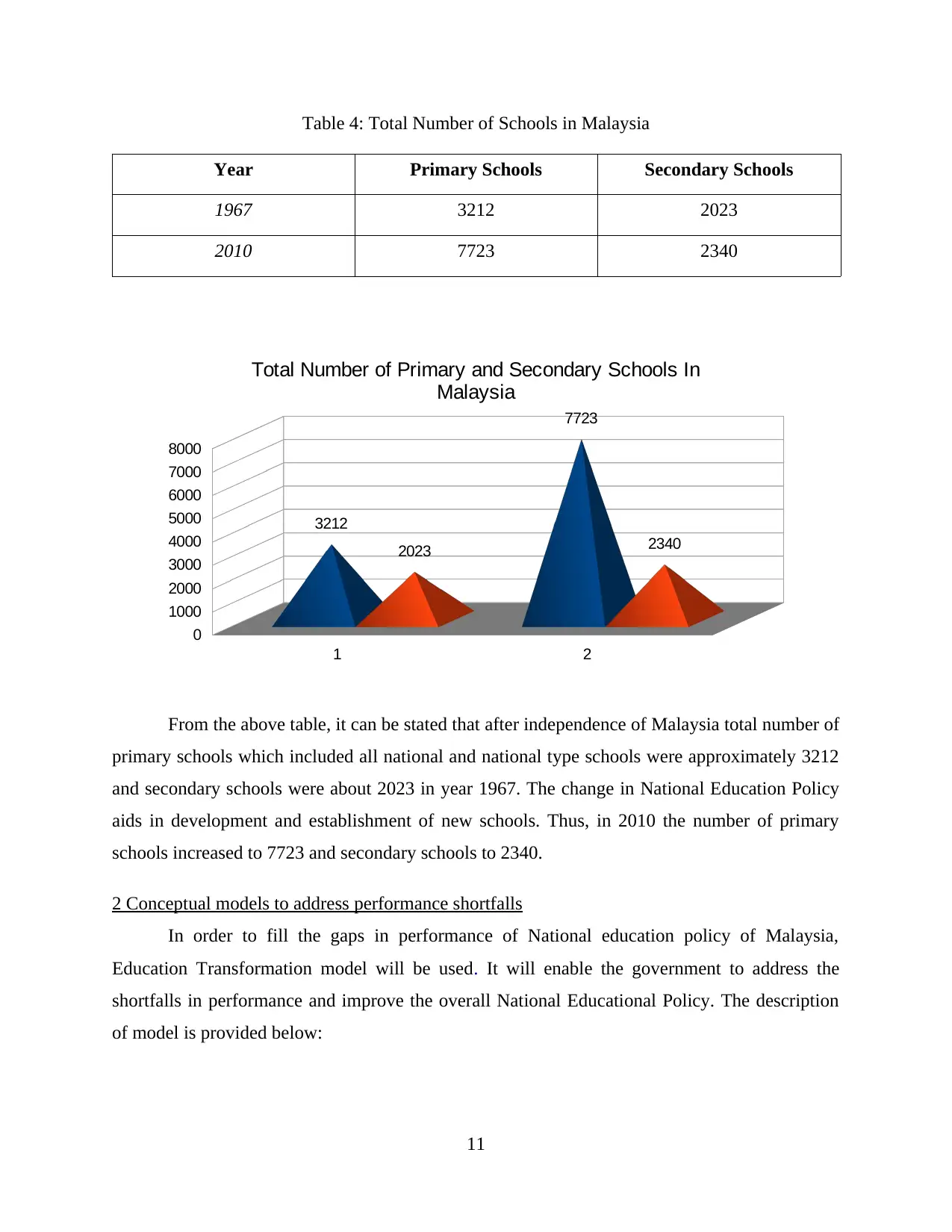
Table 4: Total Number of Schools in Malaysia
Year Primary Schools Secondary Schools
1967 3212 2023
2010 7723 2340
From the above table, it can be stated that after independence of Malaysia total number of
primary schools which included all national and national type schools were approximately 3212
and secondary schools were about 2023 in year 1967. The change in National Education Policy
aids in development and establishment of new schools. Thus, in 2010 the number of primary
schools increased to 7723 and secondary schools to 2340.
2 Conceptual models to address performance shortfalls
In order to fill the gaps in performance of National education policy of Malaysia,
Education Transformation model will be used. It will enable the government to address the
shortfalls in performance and improve the overall National Educational Policy. The description
of model is provided below:
11
1 2
0
1000
2000
3000
4000
5000
6000
7000
8000
3212
7723
2023 2340
Total Number of Primary and Secondary Schools In
Malaysia
Year Primary Schools Secondary Schools
1967 3212 2023
2010 7723 2340
From the above table, it can be stated that after independence of Malaysia total number of
primary schools which included all national and national type schools were approximately 3212
and secondary schools were about 2023 in year 1967. The change in National Education Policy
aids in development and establishment of new schools. Thus, in 2010 the number of primary
schools increased to 7723 and secondary schools to 2340.
2 Conceptual models to address performance shortfalls
In order to fill the gaps in performance of National education policy of Malaysia,
Education Transformation model will be used. It will enable the government to address the
shortfalls in performance and improve the overall National Educational Policy. The description
of model is provided below:
11
1 2
0
1000
2000
3000
4000
5000
6000
7000
8000
3212
7723
2023 2340
Total Number of Primary and Secondary Schools In
Malaysia
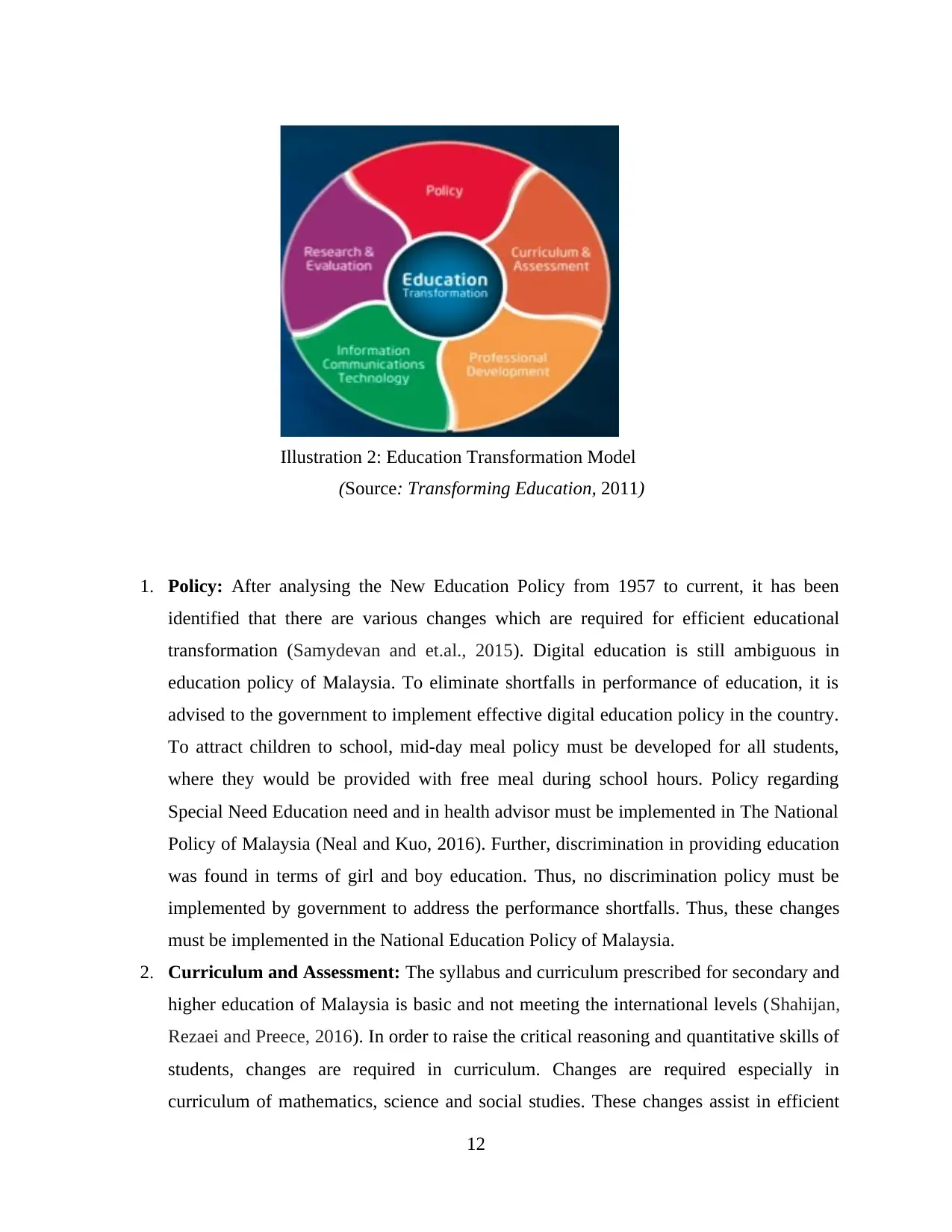
1. Policy: After analysing the New Education Policy from 1957 to current, it has been
identified that there are various changes which are required for efficient educational
transformation (Samydevan and et.al., 2015). Digital education is still ambiguous in
education policy of Malaysia. To eliminate shortfalls in performance of education, it is
advised to the government to implement effective digital education policy in the country.
To attract children to school, mid-day meal policy must be developed for all students,
where they would be provided with free meal during school hours. Policy regarding
Special Need Education need and in health advisor must be implemented in The National
Policy of Malaysia (Neal and Kuo, 2016). Further, discrimination in providing education
was found in terms of girl and boy education. Thus, no discrimination policy must be
implemented by government to address the performance shortfalls. Thus, these changes
must be implemented in the National Education Policy of Malaysia.
2. Curriculum and Assessment: The syllabus and curriculum prescribed for secondary and
higher education of Malaysia is basic and not meeting the international levels (Shahijan,
Rezaei and Preece, 2016). In order to raise the critical reasoning and quantitative skills of
students, changes are required in curriculum. Changes are required especially in
curriculum of mathematics, science and social studies. These changes assist in efficient
12
Illustration 2: Education Transformation Model
(Source: Transforming Education, 2011)
identified that there are various changes which are required for efficient educational
transformation (Samydevan and et.al., 2015). Digital education is still ambiguous in
education policy of Malaysia. To eliminate shortfalls in performance of education, it is
advised to the government to implement effective digital education policy in the country.
To attract children to school, mid-day meal policy must be developed for all students,
where they would be provided with free meal during school hours. Policy regarding
Special Need Education need and in health advisor must be implemented in The National
Policy of Malaysia (Neal and Kuo, 2016). Further, discrimination in providing education
was found in terms of girl and boy education. Thus, no discrimination policy must be
implemented by government to address the performance shortfalls. Thus, these changes
must be implemented in the National Education Policy of Malaysia.
2. Curriculum and Assessment: The syllabus and curriculum prescribed for secondary and
higher education of Malaysia is basic and not meeting the international levels (Shahijan,
Rezaei and Preece, 2016). In order to raise the critical reasoning and quantitative skills of
students, changes are required in curriculum. Changes are required especially in
curriculum of mathematics, science and social studies. These changes assist in efficient
12
Illustration 2: Education Transformation Model
(Source: Transforming Education, 2011)
⊘ This is a preview!⊘
Do you want full access?
Subscribe today to unlock all pages.

Trusted by 1+ million students worldwide
1 out of 29
Related Documents
Your All-in-One AI-Powered Toolkit for Academic Success.
+13062052269
info@desklib.com
Available 24*7 on WhatsApp / Email
![[object Object]](/_next/static/media/star-bottom.7253800d.svg)
Unlock your academic potential
Copyright © 2020–2025 A2Z Services. All Rights Reserved. Developed and managed by ZUCOL.




